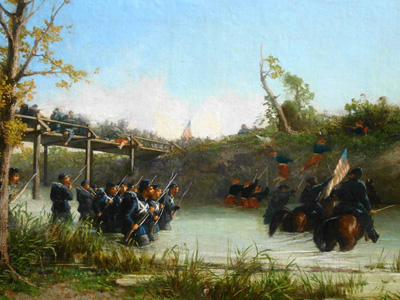An Unlocated Title: Watching the Shot

Setting the Scene for Watching the Shot
 Fig. 2-1: The keys to understanding Homer's title are three soldiers: the Confederate sniper, the Zouave soldier being shot, and the Union soldier watching the shot.
Fig. 2-1: The keys to understanding Homer's title are three soldiers: the Confederate sniper, the Zouave soldier being shot, and the Union soldier watching the shot.
The battle scene in this oil painting, 21" x 31", depicts both Confederate and Union soldiers fighting for control of a wagon bridge while simultaneously below the bridge Union soldiers wade through the water as part of a flanking maneuver to surprise the rebel enemy on the opposite side of the river. Although there are dozens of soldiers in the scene, the keys to understanding Homer’s title are three soldiers; one Confederate sniper (the shooter), one Union Zouave soldier (being shot) and one tall infantry man (the watcher) (Fig. 2-1). On the far bank Zouave soldiers, in red pants, are scrambling up the embankment, one of them has just been shot, the impact throwing his body and head backwards. Marc Simpson tells us, the Zouaves—Berber tribesmen of Algeria who fought alongside the French in the Crimean War, reportedly possessing unquenchable vigor and valor in battle—the uniforms quickly became the favorite of journalists and illustrators (2.1). Homer depicted Zouave soldiers in many of his Civil War drawings and paintings (2.2). In the battle painting the falling Zouave soldier has been shot by a confederate soldier hiding at the top of the ridge. In the entire complex battle scene this is the only soldier whose body is lurching from having just been shot. The rebel sniper has raised his head up to look over the top of the white smoke billowing from the end of his rifle. According to Civil War weapons expert J.G. Bilby, all guns and rifles during the Civil War era relied on black powder to fire the weapon, which in turn poured out thick funnels of white smoke. So much white smoke that often soldiers could not see what they had just shot at. The only remedy upon firing a shot was for the soldier to immediately lift their head as high as possible in hopes to see beyond the billowing cloud of smoke (2.3). In the entire battle scene this is the only weapon clearly being fired (see Fig. 2-2).
 Fig. 2-2: The Confederate sniper's rifle is the only weapon clearly being fired in the entire scene.
Fig. 2-2: The Confederate sniper's rifle is the only weapon clearly being fired in the entire scene.
A tall infantry man (second from the bottom left) had caught site of something in the brush atop the ridge. He has stopped moving forward and squared his body in the direction of the threat. In the entire battle scene it is only this one lone private who sees the confederate shooter. The soldier realizes too late what is happening and is left, watching the shot.
Watching the Shot. © 2025 All rights reserved. Terms of Use and Privacy Policy.
